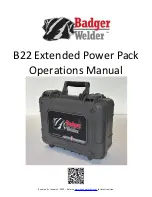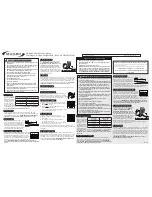
—
7. Installation
7.1. General information
Correct installation is of primary
importance. The manufacturer’s
instructions must be carefully studied
and followed. It is good practice to use
gloves, protection for the eyes, head
and lower limbs when handling the
components during the installation
work.
7.2. Installation and operating
conditions
It is particularly important to comply with the
following regulations during installation and
operaton:
•
IEC 62271-1/DIN VDE 0101
• VDE 0105: Operation of power installations
•
DIN VDE 0141: Earthing systems for installations
with rated voltage above 1 kV.
• All the accident prevention regulations in force in
the respective countries.
7.2.1. Normal conditions
Comply with the recommendations in standards IEC
62271-1 and 62271-100, i.e.:
Humidity
The average relative humidity value measured for more than 1
month must not exceed 95%
The average water vapor pressure value measured for more
24 hours must not exceed 2.2 kPa.
The average relative humidity value measured for more than 1
month must not exceed 90%
.
The average water vapor pressure value measured for more
than 1 month must not exceed 1.8 kPa.
Altitude
< 1000 m above sea level.
Ambient temperature
Maximum
+ 40 °C
Average maximum over 24 hours
+ 35 °C
Minimum (according to class – 5),
apparatus for indoor installation
– 5°
7.2.2. Special conditions
Installations over 1000 m a.s.l.
Possible, within the limits allowed by the reduction in the
dielectric strength of the air.
Increase in ambient temperature
Reduction in the rated current.
Facilitate heat dissipation by use of appropriate additional
ventilation.
Climate
To avoid the risk of corrosion or other damage in areas:
•
with a high level of humidity, and/or
•
rapid and extensive temperature variations, take
appropriate steps (for example, by using electric heaters) to
prevent condensation from forming.
Please contact ABB for special installation
requirements or other types of operating
conditions.
The areas through which power
conductors or auxiliary circuit
conductors are routed must be
protected against access by animals, as
this could lead to damage or disservice.
7.3. Preliminary operations
• Clean insulating parts with clean dry rags.
• Make sure that upper and lower terminals are clean
and free of any deformation caused by shocks
received during transport or storage.
7.4. Installation of fixed circuit-
breakers
The circuit-breaker can be installed straight onto
bearing frames provided by the customer or on
special bearing trucks (available on request).
Circuit-breakers with bearing trucks must be
fastened to the floor of their compartment at the
customer’s charge. The floor surface where the
truck wheels slide must be perfectly leveled.
A minimum degree of protection (IP2X) must be
guaranteed from the front towards live parts.
7.4.1. Assembly of circuit-breakers on trucks
provided by third parties
VD4G circuit-breakers that are not installed on ABB
trucks but on trucks provided by the customer must
be equipped with one or two additional auxiliary
contacts (operated by the mechanical lock or release
device of the circuit-breaker) which interrupt the
circuit of the shunt closing release (-MBC) during
movements to and from the isolated position.
This function is performed on ABB trucks by
auxiliary contacts -BGT1 and -BGT2, which shut off
26
V D4 G
I N S TA L L AT I O N A N D O P ER AT I N G I N S T R U C T I O N S
















































